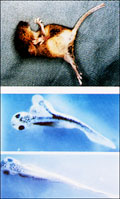  |
 |
 |
 |
Pursuing Unknown Genes Involved in the Development of the Brain
| Group
Director, |
| Dr.Katsuhiko
Mikoshiba |
|
 |
Behavioral
disorder in individuals are usually associated with deformities in the corresponding
regions of the brain. We can easily find such deformity in the cerebellum because
of its unique behavioral abnormality", said Dr. Katsuhiko Mikoshiba, Group Director
of the Developmental Brain Science Group, in our interview. Dr. Mikoshiba and
his colleagues have discovered various genes involved in the development and differentiation
of the brain in their research on the cerebellum. We asked him about the key to
the discoveries of these genes and their roles.
|
 |
| Q:
Why did you choose the subject "development and differentiation of the Brain".
for your research? |

magnified scene by clicking image
IP3receptor
deficient mouse shows combined phenotype of epileptic seizure and cerebellar ataxia(upper)
Blockage of IP3 receptor by an antibody results in conversion of ventralization
to dorsalization (lower) |
A.
The role of organs,
such as the heart, the liver or the kidney, is generally to regulate homeostasis
in our body; however, the role of the brain is different. In addition to the maintenance
of homeostasis, the brain processes and integrates information obtained from the
eyes, ears and nose and then expresses its interpretation of the information in
various forms of behavior. The particularly important behavioral activities are
speaking, listening and seeing. The fact is, we can only communicate verbally
and visually among individuals by the brain function; that is to say, the brain
is not only an organ but also the human individual him-or herself. Furthermore,
by establishing communication among individuals using the brain, we are able to
create our culture. Fascinated by the wonder of the brain, I decided to study
the brain when I was a student.
Q:
What types of molecules have you found?
A.
One of them is
a protein in the Purkinje cells called P400. In the absence of these cells, the
protein is also missing and the animal displays behavioral abnormalities. After
over a decade of research, we were able to identify the protein as the IP3 receptor,
which is involved in release of Ca2+ from its stores in the cells. We examined
the IP3 receptor by various methods such as generating a knock-out mouse by gene
targeting technique, and found that the IP3 receptor is essential to fertilization
and cell division. Furthermore, IP3 induced Ca2+ release plays an important role
in the formation of dorsoventral axis, the extension of neuronal processes and
the plasticity of the brain.
|
Q:
You also found several essential proteins.
 magnified scene by clicking
image
magnified scene by clicking
image
Role of
Zic (zinc finger protein enriched in the cerebellum)in brain development. |
A.Yes. One of these
is "Zic". This is a zinc finger protein. The protein is abundant in granule cells
of the cerebellum, and we named it "Zic" from, the first two letters of zinc,
zi, and, the first letter of cerebellum, c. In fact, the protein is associated
with important genes which greatly affect the developmental processes in the brain.
Zic became popular, because its homologs were found to be encoded by genes essential
to the development of Drosophila (fruit fly), controlling wingless and engrailed
genes. There
 magnified scene by clicking image
magnified scene by clicking image
Signal
cascade for the determination of neuronal positioning |
are five types of genes
which code for Zic. The type-1 gene affects pattern formation in the cerebellum.
Type 2 is the causal gene of 13q syndrome in humans. Type 3 is a gene which determines
right and left axis formation. We have demonstrated the function of the type-3
gene recently by reversing the parts of the heart, i.e., the right- side
parts being on the left side of the frog, Xenopus laevis. Another gene is responsible
for the positioning of neurons. We immunized a Reeler mutant mouse, which has
no folds and has disorganized neurons in the cerebellum, against a normal brain
tissue. Then, we succeeded in isolating an antibody against a Reeler-gene product
for the first time in the world (joint research with Dr. Ogawa, Dr. Nakajima and
Dr. Miyata,). Furthermore, we found a new mutant, named the "Yotari" mouse because
of its unsteady gait ("yota-ru" in Japanese), which had a genetic disorder designated
as Disabled 1. From these findings, the mechanism of neuronal positioning in the
brain is well clarified.
|
|
| Q:
What is the key to these findings? |
A.
We carried out
experiments by assuming all possibilities to neveal the mechanism of only one
pheno menon. Then, we carefully examined all the data obtained from the experiments
to determine if they agreed with the hypotheses initially formulated. When we
obtained contradictory experimental results, we consider it as a great opportunity
to determine the key to the answers. Finding the Yotari mouse, the IP3 receptor
and Zic are good examples.
|
| Q:
In conclusion, could you tell us your view of the future of research?
|
A.
If we could clarify
the mechanisms which induce development and differentiation of cells in the brain
and the functional molecules involved, then we could find the clues to revitalize
aged cells and to treat brain diseases. The mechanisms of diseases and aging of
cells are, in a way, merely a part of the process of the development and differentiation.
I believe that results of our on-going research can be effectively fed back to
the medical field. The cerebellum is developed relatively early during evolution
and it is an important region for our behavior. This is the reason that the findings
in the cerebellum can be a key to solving the mysteries of the entire brain. We
will continue pursuing the mechanisms of the cerebellum to find the key to answers.
|
| 
|
 |
 |
|
|



